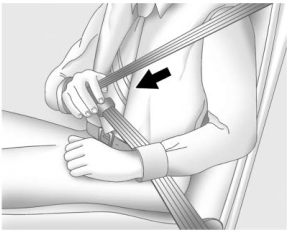Buick Encore: Airbag System / Airbag System
The vehicle has the following airbags:
- A frontal airbag for the driver
- A frontal airbag for the front outboard passenger
- A seat-mounted side impact airbag for the driver
- A seat-mounted side impact airbag for the front outboard passenger
- A roof-rail airbag for the driver and the passenger seated directly behind the driver
- A roof-rail airbag for the front outboard passenger and the passenger seated directly behind the front outboard passenger
The vehicle may have the following airbags:
- A knee airbag for the driver
- A knee airbag for the front outboard passenger
- Seat-mounted side impact airbags for the second row outboard passengers
All vehicle airbags have the word AIRBAG on the trim or on a label near the deployment opening.
For frontal airbags, the word AIRBAG is on the center of the steering wheel for the driver and on the instrument panel for the front outboard passenger.
For knee airbags, the word AIRBAG is on the lower part of the instrument panel.
For seat-mounted side impact airbags, the word AIRBAG is on the side of the seatback or side of the seat closest to the door.
For roof-rail airbags, the word AIRBAG is on the ceiling or trim.
Airbags are designed to supplement the protection provided by seat belts. Even though today's airbags are also designed to help reduce the risk of injury from the force of an inflating bag, all airbags must inflate very quickly to do their job.
Here are the most important things to know about the airbag system:
Warning
You can be severely injured or killed in a crash if you are not wearing your seat belt, even with airbags. Airbags are designed to work with seat belts, not replace them. Also, airbags are not designed to inflate in every crash. In some crashes seat belts are the only restraint. See When Should an Airbag Inflate?.
Wearing your seat belt during a crash helps reduce your chance of hitting things inside the vehicle or being ejected from it. Airbags are “supplemental restraints” to the seat belts. Everyone in the vehicle should wear a seat belt properly, whether or not there is an airbag for that person.
Warning
Because airbags inflate with great force and faster than the blink of an eye, anyone who is up against, or very close to, any airbag when it inflates can be seriously injured or killed. Do not sit unnecessarily close to any airbag, as you would be if sitting on the edge of the seat or leaning forward. Seat belts help keep you in position before and during a crash. Always wear a seat belt, even with airbags. The driver should sit as far back as possible while still maintaining control of the vehicle. The seat belts and the front outboard passenger airbags are most effective when you are sitting well back and upright in the seat with both feet on the floor.
Occupants should not lean on or sleep against the door or side windows in seating positions with seat-mounted side impact airbags and/or roof-rail airbags.
Warning
Children who are up against, or very close to, any airbag when it inflates can be seriously injured or killed. Always secure children properly in the vehicle. To read how, see Older Children or Infants and Young Children.

There is an airbag readiness light on the instrument cluster, which shows the airbag symbol. The system checks the airbag electrical system for malfunctions. The light tells you if there is an electrical problem. See Airbag Readiness Light for more information.
 Where Are the Airbags?
Where Are the Airbags?
The driver frontal airbag is in the center of
the steering wheel.
The front outboard passenger frontal airbag
is in the passenger side instrument panel...
Other information:
Buick Encore 2020-2025 Owner's Manual: Bluetooth (Voice Recognition for 8 Inch Screen)
Using Bluetooth Voice Recognition To use voice recognition, press g on the steering wheel controls. Use the commands below for the various voice features. For additional information, say “Help” while in a voice recognition menu. See Voice Recognition (8 Inch Screen) for help using voice recognition commands...
Buick Encore 2020-2025 Owner's Manual: Radio Data System (RDS)
If equipped, RDS features are available for use only on FM stations that broadcast RDS information. With RDS, the radio can: Group stations by Category (i.e., Program Type) such as Rock, Jazz, Classical, etc. Display messages from radio stations...
Categories
- Manuals Home
- Buick Encore Owners Manual
- Buick Encore Service Manual
- Settings
- Engine Heater
- Digital Speedometer
- New on site
- Most important about car
Lap-Shoulder Belt
All seating positions in the vehicle have a lap-shoulder belt.
The following instructions explain how to wear a lap-shoulder belt properly.
Adjust the seat, if the seat is adjustable, so you can sit up straight. To see how, see “Seats” in the Index.

